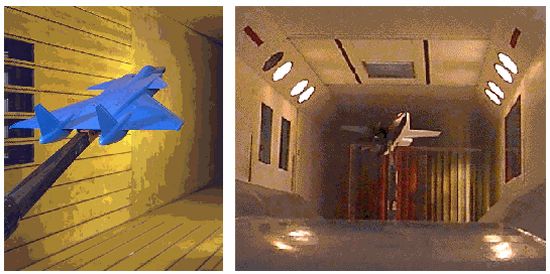|
||||||||||
|
|
||||||||||
|
||||||||||
|
|
||||||||||
|
|
|
|||||||||||||
|
Model Motion and Deformation:As might be expected, the model undergoing the aerodynamic testing typically experiences different aerodynamic loadings between wind-off and wind-on conditions. Not only can the increased aerodynamic loads move the model slightly, but the model may also deform. As the model scale and the tunnel dynamic pressure increase, these effects may become even more significant. A typical solution to this problem is to place control points on the model surface. These control points can then be compared between the wind-on and wind-off test conditions, and the proper transformations can be applied.

Models coated with PSP installed in wind tunnels
Excitation Illumination Variation:Regardless of the choice of illumination element, changes in the element's output over time are always a possibility. Even when the element itself is stable over time, it is possible that movement and deformation of the model can create an unstable excitation illumination. A common method used to account for variation in the excitation illumination is to use luminescent molecules that are insensitive to both temperature and pressure measurements. These molecules are either applied as a separate coating on a different area of the model, or blended with the PSP, but emitting in a different wavelength than the PSP molecules. These "insensitive" molecules can then be used as a reference between the wind-on and wind-off conditions, allowing the proper corrections to be made.
Mapping of the Data:When the data is acquired for analysis and reduction, problems arise from the fact that the images are two-dimensional, while the actual model is three-dimensional. Other problems are created by lens distortion, perspective effects, and model curvature (some of which are related to the three-dimensionality of the model). All of these problems must be considered in order to correctly relate any point on the two-dimensional image to the three-dimensional model. Fortunately, this problem is very common in photogrammetry, and there are many sophisticated mathematic methods available to deal with these errors.
Calibration:Before the emission intensities can be converted into pressure measurements, experimental calibration of the coefficients in the Stern-Volmer equation must be conducted. There are two methods used to calibrate PSP, the a priori method and the in situ method. The a priori method calibrates the PSP coating under static conditions. Typically a test plate is coated with the same undercoat and PSP from the same batch as that applied to the model. This test plate is then placed in a temperature and pressure controlled chamber, where intensity readings can be collected for known pressures. The in situ method calibrates the PSP by using pressure taps located in the model. The PSP is then calibrated at the locations where the pressure taps are located. Fortunately, the in situ calibration method requires fewer pressure taps than a regular tapped model without PSP, so the cost effectiveness of PSP is preserved. During either of these calibration routines, the recovery temperature over the model needs to be considered since the PSP coatings usually exhibit a temperature dependence. In the case of the a priori method, a separate measurement of the recovery temperature is required. Since the in situ method is performed at the wind-on recovery temperature, a separate temperature measurement is not required. The method does, however, require that the surface be reasonably isothermal. Techniques similar to those used to detect variation of the excitation illumination are used when the recovery temperature needs to be determined. One method is to use paint that is sensitive only to temperature, and place it at different locations on the model. On models that exhibit lateral symmetry, the temperature sensitive paint is often applied to half of the model, while the other half is coated with PSP. Another method being developed is to use a dual paint formulation in which the temperature sensitive molecules emit light in a different portion of the spectrum than the PSP. |


|
Aircraft | Design | Ask Us | Shop | Search |

|
|
| About Us | Contact Us | Copyright © 1997-2023 | |||
|
|
|||